If two separate or distinct economic systems co-exist in the same area or country, we call it a Dual Economy.
We say a country has a dual economy when the northern half develops significantly in global terms, while the southern half remains much poorer, similar to a developing country.
Economists may refer to the rich part of a country as the modern sector and the poorer part the *informal sector.
* The ‘informal sector,’ in economics, refers to the part of the economy that operates ‘below the radar’. They pay no tax because they do not declare their income to the tax authorities, they rarely offer receipts or guarantees. It is also called the shadow economy, gray economy, or underground economy.
Dual economies are more pronounced in emerging economies, such as India, Brazil, Mexico, South Africa, and Bangladesh. Later in this article, we shall be looking at these countries in more detail.
In an abstract published by The New Palgrave Dictionary of Economics, David Vines and Andrew Zeitlin wrote:
“Dual economies have asymmetric sectors, the interaction between which influences the path of development. These are typically a rural, traditional, or agricultural sector on one hand, and an urban, modern, or industrial sector on the other.”
“The relevant asymmetries are not merely technological but also include institutional, behavioral, and informational aspects.”
Dual Economy vs. Mixed Economy
Some people mistakenly use both terms interchangeably when talking about free market economies and state-controlled ones (communist systems). Their meanings are not the same!
-
A Mixed Economy
A mixed economy is one in which the state and the private sector direct the economy – there is a ‘mix’ of private and state ownership.
In the United Kingdom, for example, there are companies in the private sector such as BP and Rolls-Royce, and also in the public sector, such as the BBC, Network Rail, and Post Office Ltd.
-
A Dual Economy
As mentioned earlier, this type of economy exists when one part of the country is modern and developed, while another part remains traditional and significantly poorer.
Brazil’s Dual Economy
Brazil is a country of stark diversity and contrasts. In some parts, lifestyles resemble those of developed European nations, while in others, people live in slums or eke out a living as subsistence farmers.
-
South and Southeast Brazil
The south and southeast of the country enjoys impressive levels of development and relative wealth. The metropolitan area of Sao Paulo, Brazil’s largest conurbation, has a GDP greater than the whole of Argentina. The economy of the State of Minas Gerais, which is next to Sao Paulo, is larger than that of Chile.
-
Northeast Brazil
The northeast of the country has been a significantly poorer region since the decline of sugar cane plantations three hundred years ago.
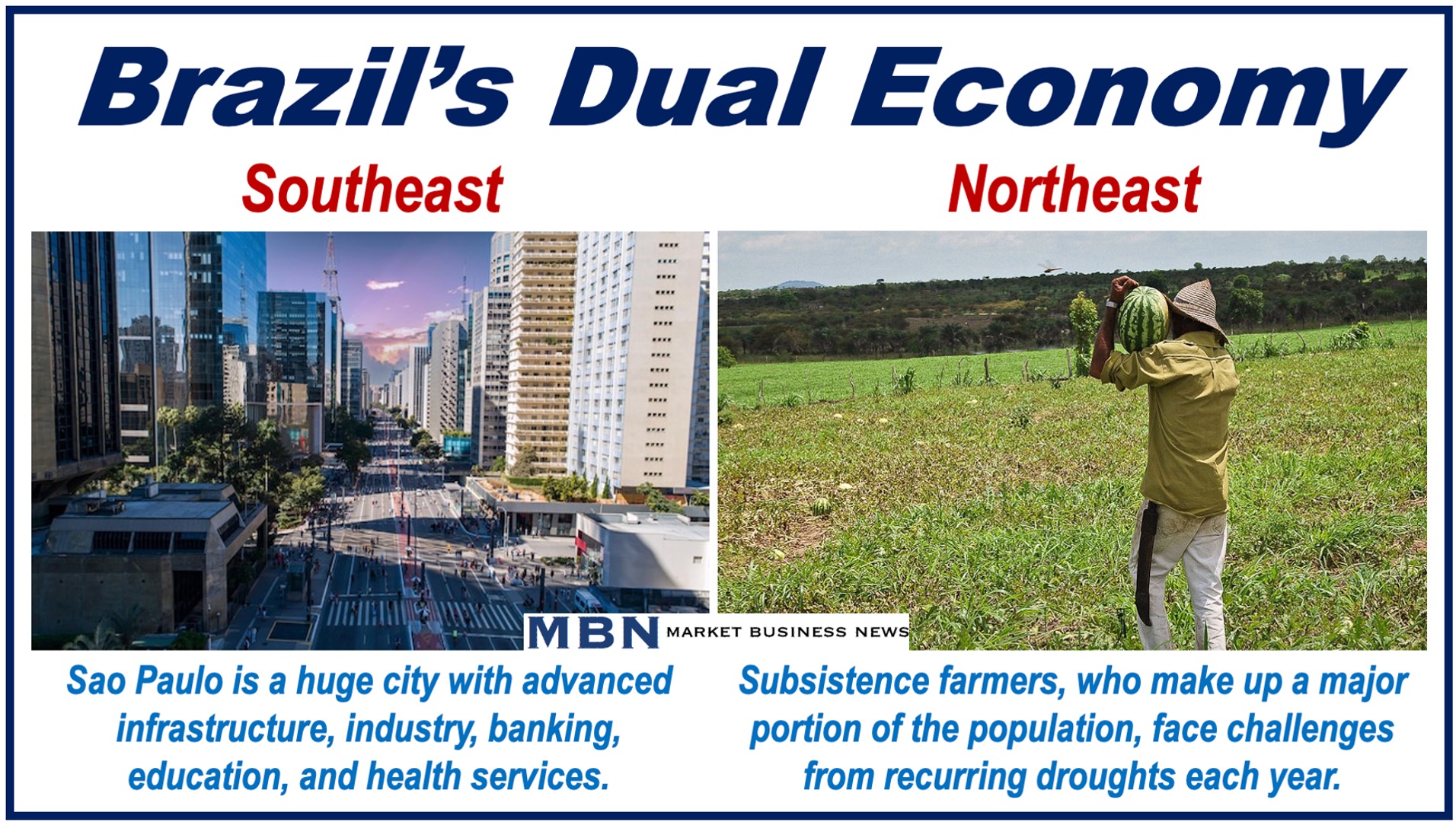
In an article published by Beyond Intractability, Anthony Talarico wrote:
“The northeast of Brazil is characterized by traditional land estate ownership with the majority of the population engaged in subsistence farming, which is usually hampered by drought every few years.”
GDP per capita in the southeast, driven by its more advanced industrial and service sectors, has consistently been more than double that of the northeast in most years over the past century.
Italy’s Dual Economy
Historically, there has been a significant economic disparity between Italy’s north and south.
The north is significantly more developed, with strong industry and infrastructure. The south struggles with unemployment, limited industry, and corruption.
Economists have long said that this divide affects Italy’s overall prosperity and social cohesion.
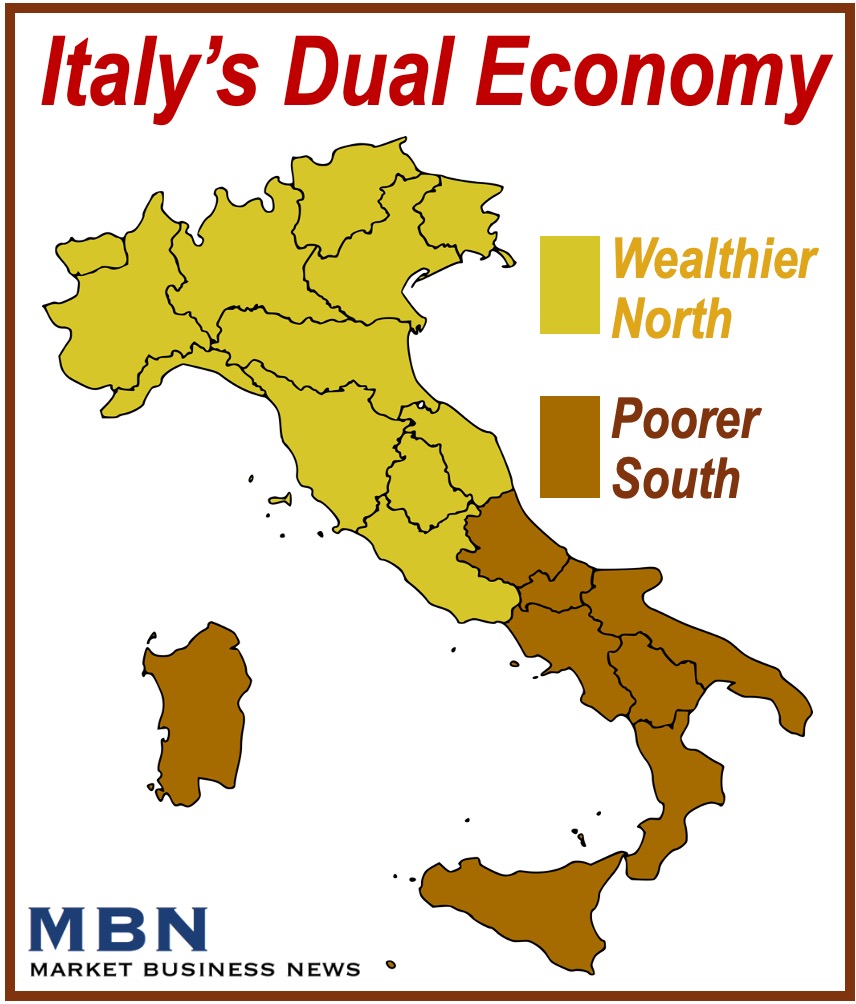
In an article published by the London School of Economics, Pietro Righi wrote:
“Italy’s economy is more geographically divided than any other country in Europe. Lombardy, in the north, has a GDP per capita equal to 127% of the EU average; the GDP of Calabria, in the south, is only 56% of the EU average (Eurostat, 2021).”
“Though the ultimate causes are contested, economic historians agree that a key proximate cause of Italy’s North-South divide is the uneven spread of industry, which is concentrated in the North.”
-
When did Italy’s Economic Divide Start?
Economic historians date Italy’s geographical divergence to the post-1937 period which was driven by reductions in transportation costs, the greater proximity of the North to European consumers, and market integration.
Some say it dates back to the country’s unification in 1861. The key entities that united to create modern Italy were Piedmont, Lombardy, Venetia, Liguria, and Emilia-Romagna (in the north), and Campania, Calabria, Sicily, and Apulia (in the south).
At that time, the northern regions were already more economically developed than the southern ones, which were mainly agrarian and less industrialized.
The northern regions of Piedmont, Lombardy, and Liguria, for example, had experienced early industrialization and were considerably more integrated into European trade networks than the southern regions of Campania, Calabria, Sicily, and Apulia, which were part of the Kingdom of the Two Sicilies.
- Quotes
Romano Prodi, who served as Prime Minister of Italy twice—from 1996 to 1998 and again from 2006 to 2008—succinctly summed up the deep divisions across Italian society by stating:
“Italy is divided between us and them, rich and poor, north and south, young and old, employed and unemployed.”
Matteo Salvini, leader of the League party since 2013 and a key political figure in Italy, also addressed the country’s dual economy, saying:
“If Rome gets to decide everything for the north and for the south, it’s not a good and just thing.”
Mexico’s Dual Economy
The north and some central parts of Mexico are highly industrialized. The city of Monterrey, in the state of Nuevo León (in the north), has a vast manufacturing hub linked to the United States.
The southern states, such as Chiapas and ….(PLEASE ADD), are much poorer. Many people in southern Mexico rely on subsistence farming and informal employment.
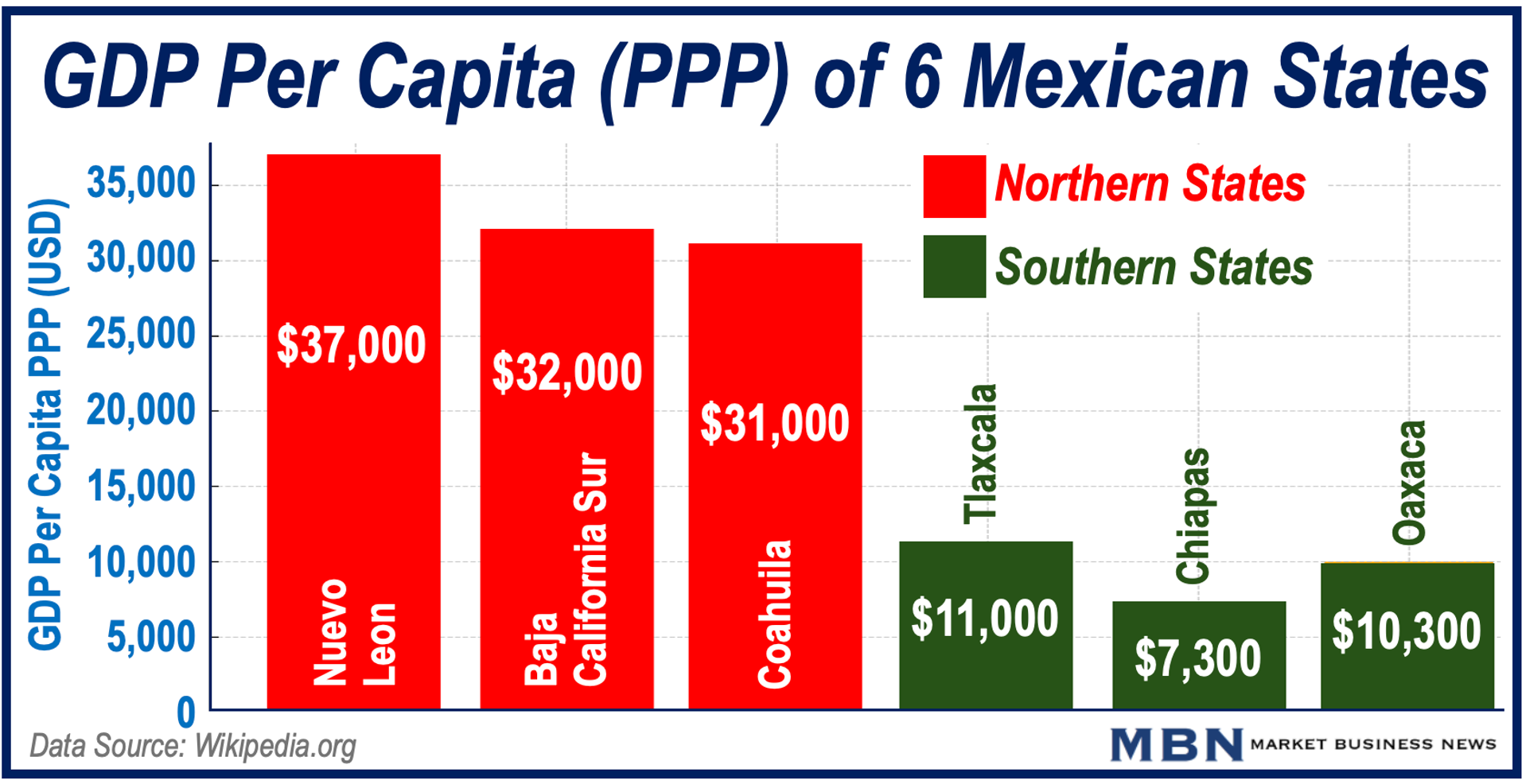
According to Wikipedia, GDP per capita in Mexico City and Neuvo Leon is more than four times greater than in the southern states of Chiapas and Oaxaca.
-
Quote
In 2021, respected political commentator Luis Rubio remarked:
“There is no issue more critical for Mexico than the poverty that characterizes the country’s South. It is an issue that impacts Mexico’s entire national life.”
South Africa
South Africa’s economy features a modern, industrialized core, especially in cities like Johannesburg, while large segments of the population live in poverty, particularly in rural areas.
World Bank country director Paul Noumba Um wrote the following in the Overcoming Poverty and Inequality report:
“On the one hand is a small high-skilled, high-productivity economy and on the other hand, a large low-skilled, low-productivity one. This assessment argues that it is this duality that has in part resulted in high wage inequality that has been steadily rising reflecting a highly polarized labor market.”
In 1994, when apartheid came to an end, economists said that South Africa was the most unequal country in the world. Unfortunately, inequality still remains stubbornly high, says the World Bank. In fact, over the last three decades, consumption inequality has increased.
China
Coastal cities like Shanghai and Shenzhen are economic powerhouses with advanced industries, while many rural interior provinces remain less developed and depend on agriculture.
Although China’s economy has grown dramatically over the last thirty or so years, that growth has been lopsided. Large conurbations have advanced significantly with fast trains and other first world infrastructures. However, many rural areas have been left behind.
In an article published by the Center for Strategic & International Studies, Ilaria Mazzocco explains that China’s recent faltering economy may not grow at the rate needed to achieve its development goals, partly because of the country’s persistent inequality.
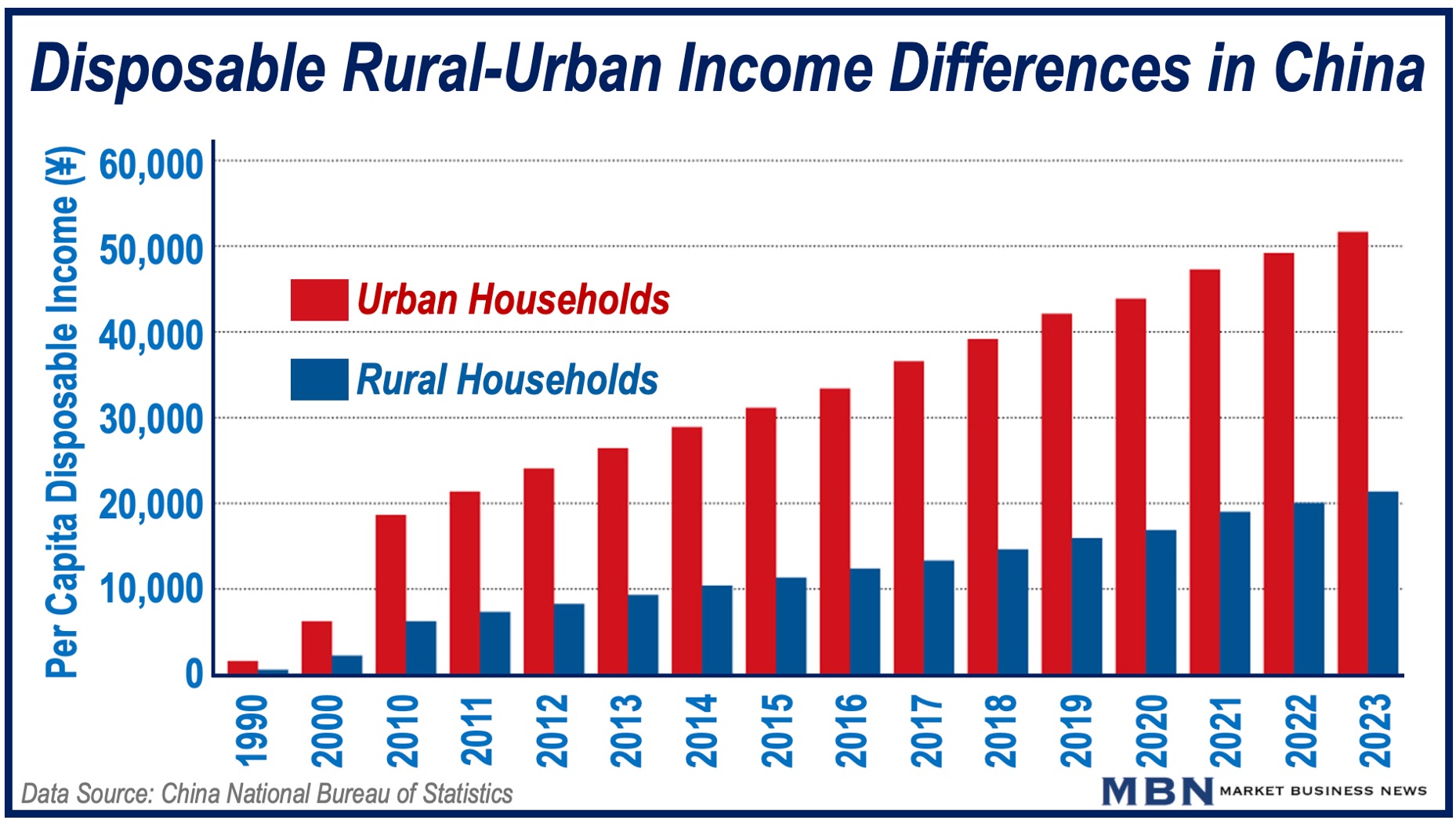
Miyashni Pillay wrote the following in a BRICS Global Television Network article in August 2024:
“China’s rapid economic growth has been one of the most remarkable success stories of the 21st century. However, beneath the surface of this booming economy lies a significant challenge: the growing divide between urban and rural areas.”
“This gap, characterized by disparities in income, education, healthcare, and access to public services, is not only a social issue but also a threat to the country’s long-term economic sustainability.”
India
Here, the divide is between the rapidly growing tech-driven urban sector and the rural economy.
India’s agricultural economy still employs much of the population but generates considerably less income.
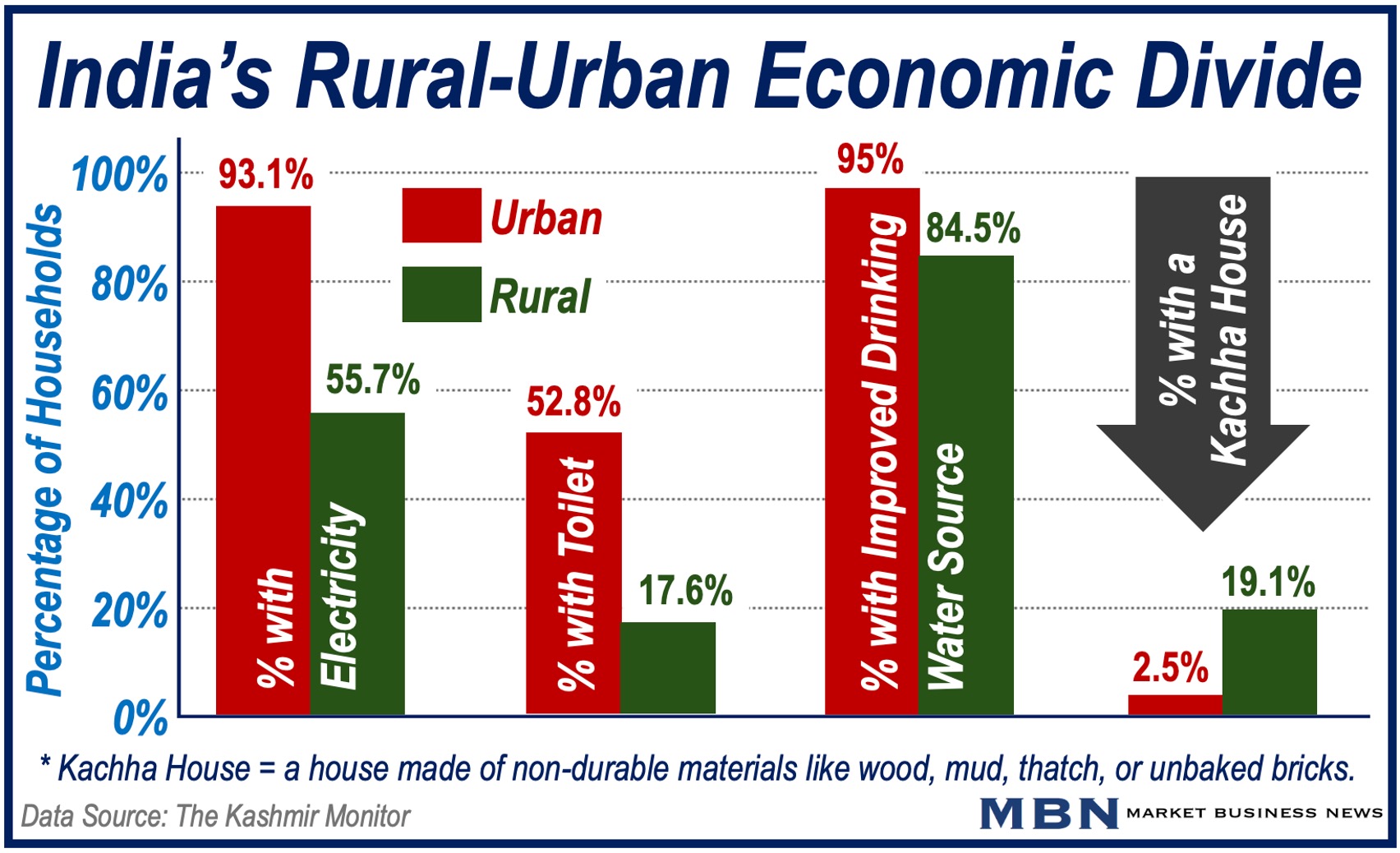
In the peer-reviewed academic journal Global Policy, Yuqing Yang, explained that India’s dual economy is hindering the country’s potential. Yang wrote:
“Fundamentally, India’s potential for development is hindered by the duality of informal and formal sectors. On the one hand, to create a pro-business environment and attract investments in manufacturing sectors, India needs to formalize its economic institutions.”
Vietnam
In Vietnam, the difference in income, access to education, health, and other services, and people’s overall standard of living between the fast-growing industrial and urban sector, in cities like Hanoi and Ho Chi Minh City, and rural areas.
As in most other countries where dualism exists, people in Vietnam’s rural areas are still heavily reliant on farming and the informal economy.
The country has transitioned rapidly into manufacturing and exports, but rural areas, particularly in the north and central highlands, lag behind in terms of development and infrastructure.
Vietnam started this century with a dual economy model, focusing its resources on industrializing its main urban areas. While showing some initial success, it has also caused significant problems.
The divide between its rural and urban areas has grown continuously over many years. During this period, the availability of high-quality labor has increased marginally.
Resource exploitation has been the main driver of the economy, which, to some extent, has disguised the underlying social and economic problems.
As a result of the country’s lopsided development, economic growth has slowed down with no sign of improvements, while macroeconomic indicators remain unstable, with a large budget deficit and increasing public debt, according to a Final Report by the Australian Centre for International Agricultural Research.
The authors of the Report wrote:
“This outcome is consistent with international lessons that the dual economy model, in most cases, will trap a country in a middle-income circle. Also, the dual economy model, with its consequences of uneven development, might be the underlying reason for socio-economic and environmental crises or even political instability.”
Russia
Russia’s urban centers like Moscow and St. Petersburg are hubs of wealth and modernization. The country’s vast rural regions, on the other hand, are far behind regarding economic opportunities, income, and infrastructure.
In an article in the Russian Journal of Economics, Yulia N. Nijulina wrote:
“Rural areas of Russia have always lagged behind urban areas in their development in terms of demographic, economic and infrastructural characteristics. Additionally, protracted urbanization and the current paradigm of agriculture in the form of large agro-industrial complexes have led to a deepening spatial polarization of rural development.”
“At the same time, despite the chronic nature of rural development lagging behind urban development, policymakers in Russia have traditionally viewed rural development as a secondary goal to agricultural production.”
A team of researchers wrote in the journal Regional Science Policy and Practice that rural-to-urban migration in Russia has been exceptionally high. This has led to urbanization pressures and depopulation of rural areas across the country, which has exacerbated the problem of high mortality and low fertility rates.
More examples of dual economies
Dual economies are common across the world, especially in developing economies. However, they also exist in some advanced economies, such as England, where the southeast of the country is richer than the north.
Here are some more examples:
-
Nigeria
Nigeria’s oil-rich south drives the country’s wealth, but the northern regions are much poorer and less industrialized, relying more on agriculture and informal economies.
-
Indonesia
Jakarta and the island of Java drive Indonesia’s economic growth, with a concentration of industry and services, whereas other regions, especially in eastern Indonesia, remain underdeveloped and reliant on traditional economies.
-
Egypt
Urban areas, particularly Cairo, have modern industries and services, while much of rural Egypt remains dependent on subsistence agriculture and has high levels of poverty.
-
Argentina
The capital Buenos Aires is highly developed with advanced industries, but many interior regions remain reliant on agriculture, with significantly lower levels of development and income.
-
Philippines
The Philippines has a dual economy where urban regions, particularly Metro Manila, Cebu, and Davao, have thriving services and business process outsourcing (BPO) industries.
Many rural regions, especially in Mindanao and the Visayas, however, remain poor and depend largely on agriculture and the informal economy, with limited access to education and infrastructure.
-
Colombia
Colombia’s dual economy is evident in the contrast between prosperous urban centers like Bogotá and Medellín, which have developed strong financial, manufacturing, and services sectors, and rural areas.
Conflict-affected rural regions, where agriculture remains the primary source of income and sustenance, suffer from the most severe lack of services and infrastructure.
Final Thoughts
Let’s recap. Dual economies exist where one part of a country is modern, industrialized and relatively wealthy, while another part is underdeveloped. This economic model, as seen in several countries such as Vietnam, Brazil, Italy, and Mexico, tends to lead to significant, economic, social, academic, and infrastructural disparities.
While urban areas experience growth and prosperity, rural or underdeveloped regions remain reliant on agriculture and informal economies, exacerbating inequality.
The persistence of a dual economy can undermine a country’s effort to attain sustainable development and social cohesion. It risks remaining trapped in a cycle of middle-income stagnation and uneven growth. Addressing these imbalances is crucial for long-term economic stability and equity.
